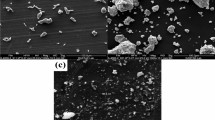Abstract
LM13/12wt.%Si3N43wt.%Gr hybrid composite was fabricated by liquid metallurgy route and its tribological characteristics were tested using pin-on-disc tribometer. The experiments were conducted as per L27 orthogonal array to study the influence of process parameter at normal and elevated temperature (150 °C) by varying process parameters such as load (10, 20, 30 N), sliding velocity (1, 2, 3 m/s) and sliding distance (750, 1250, 1750 m). The results revealed that the wear rate at both temperatures was proportional to load due to the stress induced which fractures Si3N4 particles and stripes aluminium matrix. As the sliding velocity increases, wear rate showed an increasing trend due to three body abrasion from eroded Si3N4 grits. The wear rate was inversely proportional to sliding distance, because of MML (Mechanically mixed layer) formed from chemical reactions between tribo-layers. When load increases COF (Coefficient of friction) decreases then increases due to lubricating and tillage effect. As velocity and distance increases, COF decreases due to thermal softening, hardening of layer and also the lubrication effect produced by chemical reactions. Analysis of variance (ANOVA) and S/N ratio at room temperature and elevated temperature for both Wear rate and COF were developed to study the most significant parameters on corresponding responses. Confirmation experiments were conducted to validate multi-linear regression model. Worn surfaces were examined using scanning electron microscope (SEM) to investigate wear characteristics. Energy dispersive X-ray spectroscopy (EDAX) and X-ray diffraction (XRD) results confirmed the formation of MML and different phases formed during wear mechanism. The developed material can be used to fabricate cylinder liners, cylinder blocks and brake rotors.
Similar content being viewed by others
References
Ralph B, Yuen HC, Lee WB (1997) The processing of metal matrix composites - an overview. J Mater Process Technol 63:339–353
Anthony M, Schultz BF, Pradeep R (2012) Metal matrix composites. Adv Mater Process 1:19–23
Saravanan C, Subramanian K, Sivakumar DB, Sathyanandhan M, Sankara Narayanan R (2015) Fabrication of aluminium metal matrix composite - a review. J Chem Pharm Sci 7:82– 87
Nassar AE, Nassar EE (2017) Properties of aluminum matrix Nano composites prepared by powder metallurgy processing. J King Saud Univ-Eng Sci 29:295–299
Vinoth KS, Subramanian R, Dharmalingam S, Anandavel B (2012) Mechanical and tribological characteristics of stir-cast Al-Si10Mg and self-lubricating Al-Si10Mg/MoS2 composites. Mater Technol 46:497–501
Daniel S, Harish G (2014) A study on the behaviour of aluminium alloy (LM13) reinforced with nano ZrO2 particulate. IOSR J Eng 4:58–62
Venkat Prasat S, Subramanian R, Radhika N, Anandavel B (2011) Dry sliding wear and friction studies on AlSi10Mg–fly ash–graphite hybrid metal matrix composites using Taguchi method. Tribol Mater Surf Interfaces 5:72–81
Rajesh S, Gopala Krishna A, Rama Murty Raju P, Duraiselvam M (2014) Statistical analysis of dry sliding wear behavior of graphite reinforced aluminum MMCs. Procedia Mater Sci 6:1110–1120
Vyasaraj M, Gururaj P, Mrityunjay D, Gaitonde VN, Siddhalingeshwar IG, Kishore Vasanth CS, Nikhil G (2015) Dry sliding wear of epoxy/cenosphere syntactic foams. Tribol Int 92:425–438
Kanthavel K, Sumesh KR, Saravanakumar P (2016) Study of tribological properties on Al/Al2O3/MoS2 hybrid composite processed by powder metallurgy. Alexandria Eng J 55:13–17
Mohammed A, Marshall MB, Lewis R (2015) Development of a method for assessing erosive wear damage on dies used in aluminium casting. Wear 332:1215–1224
Gurcan AB, Baker TN (1995) Wear behaviour of AA6061 aluminium alloy and its composites. Wear 188:185–191
Radhika N, Balaji TV, Palaniappan S (2015) Studies on mechanical properties and tribological behaviour of LM25/SiC/Al2O3 composites. J Eng Sci Technol 10:134–144
Rahaman ML, Zhang L (2017) An investigation into the friction and wear mechanisms of aluminium high silicon alloy under contact sliding. Wear 376:940–946
Sharma P, Khanduja D, Sharma S (2016) Dry sliding wear investigation of Al6082/Gr metal matrix composites by response surface methodology. J Mater Res Technol 5:29–36
Anitha P, Shrinivas Balraj U (2017) Dry sliding wear performance of Al/7075/Al2O3p/Grp hybrid metal matrix composites. Mater Today Proceed 4:3033–3042
Girish BM, Satish BM, Sadanand S (2016) Optimization of wear behavior of magnesium alloy AZ91 hybrid composites using taguchi experimental design. Metall Mater Trans 47A:3193
Wang Y-Q, Song J-I (2011) Dry sliding wear behavior of Al2O3 fiber and SiC particle reinforced aluminium based MMCs fabricated by squeeze casting method. Trans Nonferrous Meth Soc Chin 11:1441–1448
Radhika N, Subramanian R, Venkat Prasat S, Anandavel B (2012) Dry sliding wear behaviour of aluminium/alumina/graphite hybrid metal matrix composites. Ind Lubr Tribol 64:359–366
Radhika N, Subramanian R (2013) Effect of reinforcement on wear behaviour of aluminium hybrid composites. Tribol Mater Surf Interfaces 7:36–41
Suryanarayana RC, Khan S, Koppad PG, Khan Z (2013) Tribological behaviour of the hot extruded Al6061-Si3N4 composite. ASME 2013 Int. Mech. Eng. Congress Exposition. ASME
Arik H (2008) Effect of mechanical alloying process on mechanical properties of a-Si3N4 reinforced aluminum-based composite materials. Mater Des 29:1856–1861
Devarajaiah RM, Suresha B (2016) Role of organo-modified montmorillonite nanoparticles on wet sand abrasion of carbon fabric reinforced epoxy composites. Ind J Eng Mater Sci 23:411–417
Al-Samarai RA, Haftirman AKR, Al-Douri Y (2012) Effect of load and sliding speed on wear and friction of aluminum – silicon casting alloy. Int J Sci Res Publ 2:1–7
Prasad N, Sutar H, Mishra SC, Sahoo SK, Acharya SK (2013) Dry sliding wear behavior of aluminium matrix composite using red mud an industrial waste. Int Res J Pure Appl Chem 3:59–74
Straffelini G, Pellizzari M, Molinari A (2004) Influence of load and temperature on the dry sliding behaviour of Al-based metal-matrix-composites against friction material. Wear 256:754–763
Kumar V, Kumar J, Kumar S (2016) Study of wear behaviour of aluminium metal matrix composite reinforced with SiC. Int Res J Eng Technol 3:573–577
Kramer B (1987) On tool materials for high speed machining. J Eng Ind 109:87–91
Gates JD (1998) Two-body and three-body abrasion: a critical discussion. Wear 24:139–146
Sharma SC (2001) The sliding wear behavior of Al6061–garnet particulate composites. Wear 249:1036–1045
Author information
Authors and Affiliations
Corresponding author
Rights and permissions
About this article
Cite this article
Raj, N., Radhika, N. Tribological Characteristics of LM13/Si3N4/Gr Hybrid Composite at Elevated Temperature. Silicon 11, 947–960 (2019). https://doi.org/10.1007/s12633-018-9893-1
Received:
Accepted:
Published:
Issue Date:
DOI: https://doi.org/10.1007/s12633-018-9893-1




